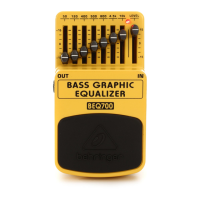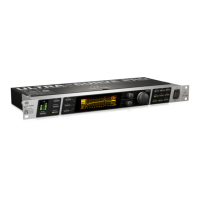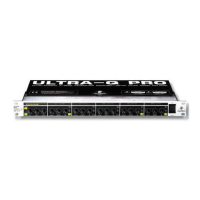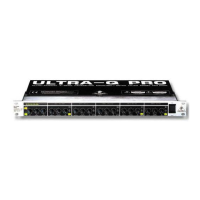9 ULTRAGRAPH PRO FBQ6200/FBQ3102/FBQ1502 User Manual
3. Application Examples
The exible concept of the ULTRAGRAPH PRO models, with the diverse
possibilities in sound processing, open up an entire range of application
possibilities for you. Only the most typical applications with their settings will be
presented here.
XENYX X2442USB
ULTRAGRAPH PRO FBQ6200
Main inserts
l & r
Inputs
l & r
Outputs
l & r
EP2000
EUROLIVE B1520 PRO
Fig. 3.1: The ULTRAGRAPH PRO FBQ6200 as master equalizer
3.1 Master equalizer in sound
reinforcementsystems
This diagram shows a typical set-up with the ULTRAGRAPHPRO models
(seeg.3.1).
To achieve optimal results, you should pay attention to several issues:
Before you start correcting the frequency response of a setup, it is advisable to
rst let the music and other sound sources run “uncorrected”, as this is something
that has proven itself in practice. If distortion occurs, such overdriving is the rst
issue to be overcome in your setup. Loudspeaker location is also very important.
No equalizer in this world can signicantly correct the dull sound created through
reexion of wall structures and ceilings. Often, very dramatic improvements can
be made by simply placing and aligning speakers correctly.
If you are using an active multi-way system you should take some run-time and
phase correction measures before you work with the ULTRAGRAPH PRO (our
crossover network SUPER-XPRO CX3400 provides all the necessary tools with
its variable split frequencies, phase reverse switches and electronic run-time
correction facility). Onlyafter making these preliminary adjustments should you
start implementing them on your ULTRAGRAPHPRO.
Disturbing noise (e. g. mains-induced hum) as well as narrow-band resonances
should rst be tackled by using the ULTRAGRAPHPRO (also see ch. 3.2.1).
Youshould denitely perform all these adjustments before modifying the
overallsound.
Now you have a basic setup and now it’s time to start ne-tuning your sound.
Some ground rules:
A linear response curve is not ideal for every application. For example,
whendealing with the spoken word, intelligibility is what is most important.
Therefore,thetransmission curve should drop o in the bass segment of the
signal because otherwise only interference is transmitted.
In general, extremely low and high frequencies are transmitted with much
lower amplitudes. There is no sense in “forcing” a small full-range speaker to
reproduce frequencies below 50 Hz; apart from a need for higher power reserves,
speakerdamage will be the most likely result.
◊ Always respect the physical limitations of your system.
After setting up your system as precisely as possible to the desired transmission
curve, walk around the venue in order to get an impression of what your signal
sounds like in dierent locations. Do not forget to take regular breaks while you
do this, and also try to use various program sources to truly develop a feeling for
what your system really sounds like and how the venue carries the sound.
◊ Setting up your equalizer well takes a lot of time and patience! If you
notice that only extreme settings on your equalizer create a usable
frequency response, this is probably a good indication that a cardinal
mistake may have been committed elsewhere in the P.A. system or
room acoustics.
An equalizer is no solution for bad equipment, but it is an extremely useful and
eective sound tool for musical ne-tuning. Fine-tuning often leads to amazing
improvements in acoustic penetration and in the overall sound quality of your
entire setup.

